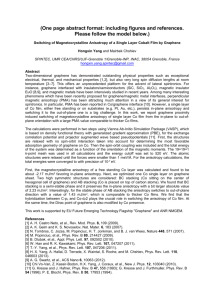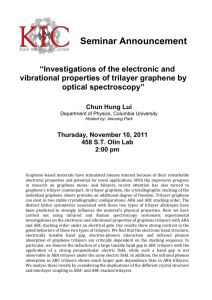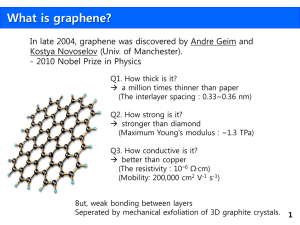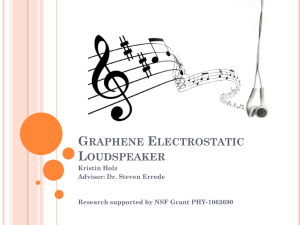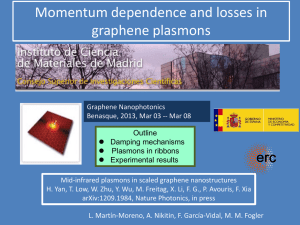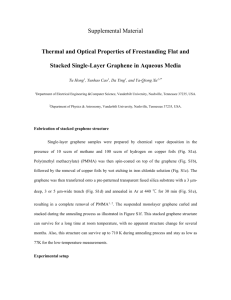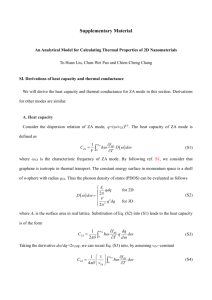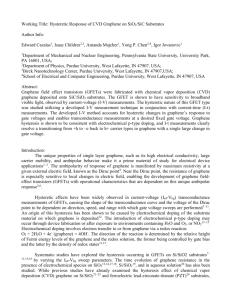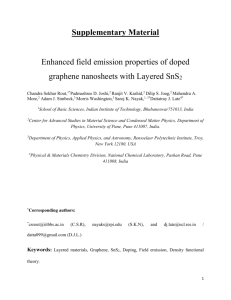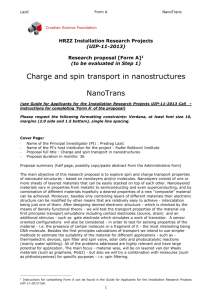Tunable transmission in a graphene photonic crystal in mid
advertisement
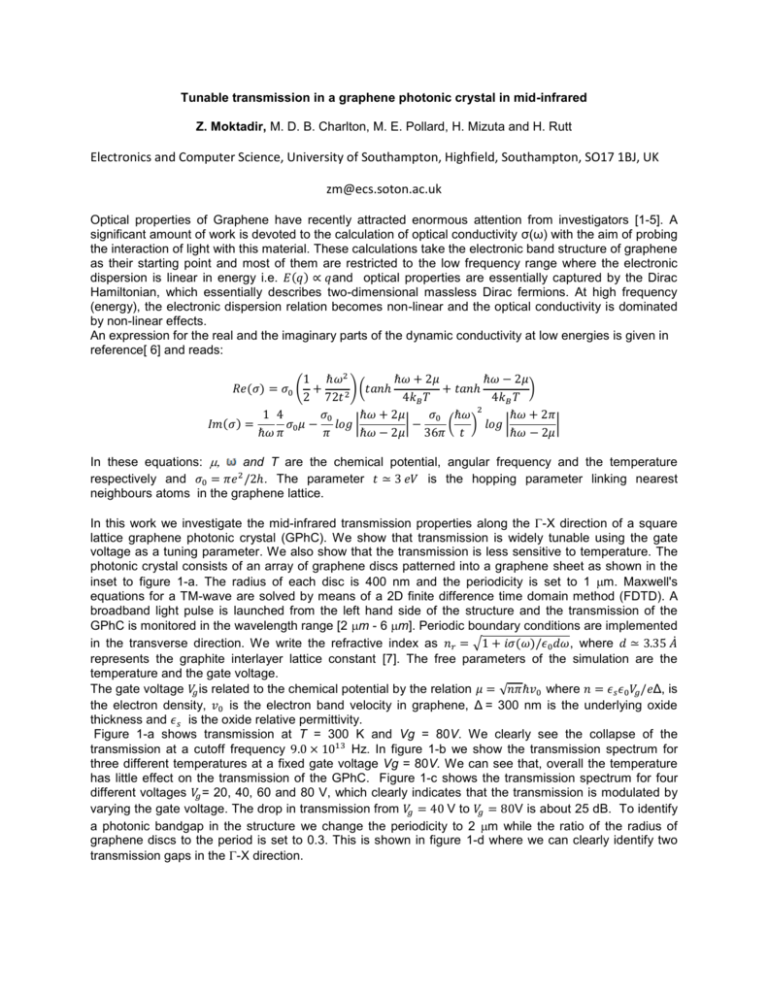
Tunable transmission in a graphene photonic crystal in mid-infrared Z. Moktadir, M. D. B. Charlton, M. E. Pollard, H. Mizuta and H. Rutt Electronics and Computer Science, University of Southampton, Highfield, Southampton, SO17 1BJ, UK zm@ecs.soton.ac.uk Optical properties of Graphene have recently attracted enormous attention from investigators [1-5]. A significant amount of work is devoted to the calculation of optical conductivity σ(ω) with the aim of probing the interaction of light with this material. These calculations take the electronic band structure of graphene as their starting point and most of them are restricted to the low frequency range where the electronic dispersion is linear in energy i.e. 𝐸(𝑞) ∝ 𝑞and optical properties are essentially captured by the Dirac Hamiltonian, which essentially describes two-dimensional massless Dirac fermions. At high frequency (energy), the electronic dispersion relation becomes non-linear and the optical conductivity is dominated by non-linear effects. An expression for the real and the imaginary parts of the dynamic conductivity at low energies is given in reference[ 6] and reads: 1 ℏ𝜔2 ℏ𝜔 + 2𝜇 ℏ𝜔 − 2𝜇 𝑅𝑒(𝜎) = 𝜎0 ( + ) (𝑡𝑎𝑛ℎ + 𝑡𝑎𝑛ℎ ) 2 2 72𝑡 4𝑘𝐵 𝑇 4𝑘𝐵 𝑇 1 4 𝜎0 ℏ𝜔 + 2𝜇 𝜎0 ℏ𝜔 2 ℏ𝜔 + 2𝜋 𝐼𝑚(𝜎) = 𝜎0 𝜇 − 𝑙𝑜𝑔 | |− ( ) 𝑙𝑜𝑔 | | ℏ𝜔 𝜋 𝜋 ℏ𝜔 − 2𝜇 36𝜋 𝑡 ℏ𝜔 − 2𝜇 In these equations: and T are the chemical potential, angular frequency and the temperature 2 respectively and 𝜎0 = 𝜋𝑒 /2ℎ. The parameter 𝑡 ≃ 3 𝑒𝑉 is the hopping parameter linking nearest neighbours atoms in the graphene lattice. In this work we investigate the mid-infrared transmission properties along the -X direction of a square lattice graphene photonic crystal (GPhC). We show that transmission is widely tunable using the gate voltage as a tuning parameter. We also show that the transmission is less sensitive to temperature. The photonic crystal consists of an array of graphene discs patterned into a graphene sheet as shown in the inset to figure 1-a. The radius of each disc is 400 nm and the periodicity is set to 1 m. Maxwell's equations for a TM-wave are solved by means of a 2D finite difference time domain method (FDTD). A broadband light pulse is launched from the left hand side of the structure and the transmission of the GPhC is monitored in the wavelength range [2 m - 6 m]. Periodic boundary conditions are implemented in the transverse direction. We write the refractive index as 𝑛𝑟 = √1 + 𝑖𝜎(𝜔)/𝜖0 𝑑𝜔, where 𝑑 ≃ 3.35 𝐴̇ represents the graphite interlayer lattice constant [7]. The free parameters of the simulation are the temperature and the gate voltage. The gate voltage 𝑉𝑔 is related to the chemical potential by the relation 𝜇 = √𝑛𝜋ℏ𝑣0 where 𝑛 = 𝜖𝑠 𝜖0 𝑉𝑔 /𝑒Δ, is the electron density, 𝑣0 is the electron band velocity in graphene, Δ = 300 nm is the underlying oxide thickness and 𝜖𝑠 is the oxide relative permittivity. Figure 1-a shows transmission at T = 300 K and Vg = 80V. We clearly see the collapse of the transmission at a cutoff frequency 9.0 × 1013 Hz. In figure 1-b we show the transmission spectrum for three different temperatures at a fixed gate voltage Vg = 80V. We can see that, overall the temperature has little effect on the transmission of the GPhC. Figure 1-c shows the transmission spectrum for four different voltages 𝑉𝑔 = 20, 40, 60 and 80 V, which clearly indicates that the transmission is modulated by varying the gate voltage. The drop in transmission from 𝑉𝑔 = 40 V to 𝑉𝑔 = 80V is about 25 dB. To identify a photonic bandgap in the structure we change the periodicity to 2 m while the ratio of the radius of graphene discs to the period is set to 0.3. This is shown in figure 1-d where we can clearly identify two transmission gaps in the -X direction. This study shows that graphene can be used as an efficient light modulator in mid-infrared range of the spectrum, despite the fact that there are several practical challenges to overcome; mainly in-plane coupling of light to a two-dimensional graphene sheet. References [1] V. P. Gusynin, S. G. Sharapov, and J. P. Carbotte, Int. J. Mod. Phys. B 21, 4611 (2007) [2] N. M. R. Peres, F. Guinea, and A. H. Castro Neto, Phys. Rev. B 73, 125411 (2006). [3] L. A. Falkovsky and A. A. Varlamov, Eur. Phys. J. B 56, 281 (2007) . [4] L. A. Falkovsky and S. S. Pershoguba, Phys. Rev. B 76, 153410 (2007). [5] A. B. Kuzmenko, E. van Heumen, F. Carbone, and D. van der Marel, Phys. Rev. Lett. 100, 117401 (2008). [6] T. Stauber, N. M. R. Peres, and A. K. Geim , Phys. Rev. B 78, 085432 (2008) [7] T. G. Pedersen et al. Phys. Rev. B 77, 245431 (2008) (a) (c) (b) (d) Figure 1: a) Transmission spectrum at 𝑉𝑔 =80 V and T=300 K. The inset shows the GPhC structure, b) transmission at fixed voltage 𝑉𝑔 = 80 V and at three different temperatures, c) transmission at fixed temperature T= 300 K and at values of 𝑉𝑔 =20, 40, 60 , and 80 V, d) transmission of a GPhC with a period of 2 m and a radius of the graphene discs of 600 nm, showing a photonic band gap.



